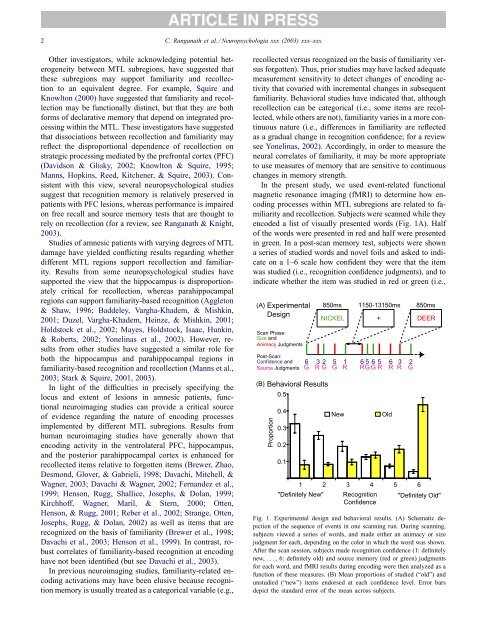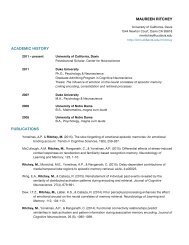Dissociable correlates of recollection and familiarity ... - ResearchGate
Dissociable correlates of recollection and familiarity ... - ResearchGate
Dissociable correlates of recollection and familiarity ... - ResearchGate
Create successful ePaper yourself
Turn your PDF publications into a flip-book with our unique Google optimized e-Paper software.
2 C. Ranganath et al. / Neuropsychologia xxx (2003) xxx–xxxOther investigators, while acknowledging potential heterogeneitybetween MTL subregions, have suggested thatthese subregions may support <strong>familiarity</strong> <strong>and</strong> <strong>recollection</strong>to an equivalent degree. For example, Squire <strong>and</strong>Knowlton (2000) have suggested that <strong>familiarity</strong> <strong>and</strong> <strong>recollection</strong>may be functionally distinct, but that they are bothforms <strong>of</strong> declarative memory that depend on integrated processingwithin the MTL. These investigators have suggestedthat dissociations between <strong>recollection</strong> <strong>and</strong> <strong>familiarity</strong> mayreflect the disproportional dependence <strong>of</strong> <strong>recollection</strong> onstrategic processing mediated by the prefrontal cortex (PFC)(Davidson & Glisky, 2002; Knowlton & Squire, 1995;Manns, Hopkins, Reed, Kitchener, & Squire, 2003). Consistentwith this view, several neuropsychological studiessuggest that recognition memory is relatively preserved inpatients with PFC lesions, whereas performance is impairedon free recall <strong>and</strong> source memory tests that are thought torely on <strong>recollection</strong> (for a review, see Ranganath & Knight,2003).Studies <strong>of</strong> amnesic patients with varying degrees <strong>of</strong> MTLdamage have yielded conflicting results regarding whetherdifferent MTL regions support <strong>recollection</strong> <strong>and</strong> <strong>familiarity</strong>.Results from some neuropsychological studies havesupported the view that the hippocampus is disproportionatelycritical for <strong>recollection</strong>, whereas parahippocampalregions can support <strong>familiarity</strong>-based recognition (Aggleton& Shaw, 1996; Baddeley, Vargha-Khadem, & Mishkin,2001; Duzel, Vargha-Khadem, Heinze, & Mishkin, 2001;Holdstock et al., 2002; Mayes, Holdstock, Isaac, Hunkin,& Roberts, 2002; Yonelinas et al., 2002). However, resultsfrom other studies have suggested a similar role forboth the hippocampus <strong>and</strong> parahippocampal regions in<strong>familiarity</strong>-based recognition <strong>and</strong> <strong>recollection</strong> (Manns et al.,2003; Stark & Squire, 2001, 2003).In light <strong>of</strong> the difficulties in precisely specifying thelocus <strong>and</strong> extent <strong>of</strong> lesions in amnesic patients, functionalneuroimaging studies can provide a critical source<strong>of</strong> evidence regarding the nature <strong>of</strong> encoding processesimplemented by different MTL subregions. Results fromhuman neuroimaging studies have generally shown thatencoding activity in the ventrolateral PFC, hippocampus,<strong>and</strong> the posterior parahippocampal cortex is enhanced forrecollected items relative to forgotten items (Brewer, Zhao,Desmond, Glover, & Gabrieli, 1998; Davachi, Mitchell, &Wagner, 2003; Davachi & Wagner, 2002; Fern<strong>and</strong>ez et al.,1999; Henson, Rugg, Shallice, Josephs, & Dolan, 1999;Kirchh<strong>of</strong>f, Wagner, Maril, & Stern, 2000; Otten,Henson, & Rugg, 2001; Reber et al., 2002; Strange, Otten,Josephs, Rugg, & Dolan, 2002) as well as items that arerecognized on the basis <strong>of</strong> <strong>familiarity</strong> (Brewer et al., 1998;Davachi et al., 2003; Henson et al., 1999). In contrast, robust<strong>correlates</strong> <strong>of</strong> <strong>familiarity</strong>-based recognition at encodinghave not been identified (but see Davachi et al., 2003).In previous neuroimaging studies, <strong>familiarity</strong>-related encodingactivations may have been elusive because recognitionmemory is usually treated as a categorical variable (e.g.,recollected versus recognized on the basis <strong>of</strong> <strong>familiarity</strong> versusforgotten). Thus, prior studies may have lacked adequatemeasurement sensitivity to detect changes <strong>of</strong> encoding activitythat covaried with incremental changes in subsequent<strong>familiarity</strong>. Behavioral studies have indicated that, although<strong>recollection</strong> can be categorical (i.e., some items are recollected,while others are not), <strong>familiarity</strong> varies in a more continuousnature (i.e., differences in <strong>familiarity</strong> are reflectedas a gradual change in recognition confidence; for a reviewsee Yonelinas, 2002). Accordingly, in order to measure theneural <strong>correlates</strong> <strong>of</strong> <strong>familiarity</strong>, it may be more appropriateto use measures <strong>of</strong> memory that are sensitive to continuouschanges in memory strength.In the present study, we used event-related functionalmagnetic resonance imaging (fMRI) to determine how encodingprocesses within MTL subregions are related to <strong>familiarity</strong><strong>and</strong> <strong>recollection</strong>. Subjects were scanned while theyencoded a list <strong>of</strong> visually presented words (Fig. 1A). Half<strong>of</strong> the words were presented in red <strong>and</strong> half were presentedin green. In a post-scan memory test, subjects were showna series <strong>of</strong> studied words <strong>and</strong> novel foils <strong>and</strong> asked to indicateon a 1–6 scale how confident they were that the itemwas studied (i.e., recognition confidence judgments), <strong>and</strong> toindicate whether the item was studied in red or green (i.e.,(A) ExperimentalDesignScan Phase:Size <strong>and</strong>Animacy JudgmentsPost-Scan:Confidence <strong>and</strong>Source Judgments(B) Behavioral ResultsProportion0.50.40.30.20.1850msNICKEL1150-13150ms6 3 2 5 1 656 5 6 3 2G RG G R RGGRR R GNew+Old850msDEER1 2 3 4 5 6"Definitely New" RecognitionConfidence"Definitely Old"Fig. 1. Experimental design <strong>and</strong> behavioral results. (A) Schematic depiction<strong>of</strong> the sequence <strong>of</strong> events in one scanning run. During scanning,subjects viewed a series <strong>of</strong> words, <strong>and</strong> made either an animacy or sizejudgment for each, depending on the color in which the word was shown.After the scan session, subjects made recognition confidence (1: definitelynew, ..., 6: definitely old) <strong>and</strong> source memory (red or green) judgmentsfor each word, <strong>and</strong> fMRI results during encoding were then analyzed as afunction <strong>of</strong> these measures. (B) Mean proportions <strong>of</strong> studied (“old”) <strong>and</strong>unstudied (“new”) items endorsed at each confidence level. Error barsdepict the st<strong>and</strong>ard error <strong>of</strong> the mean across subjects.




